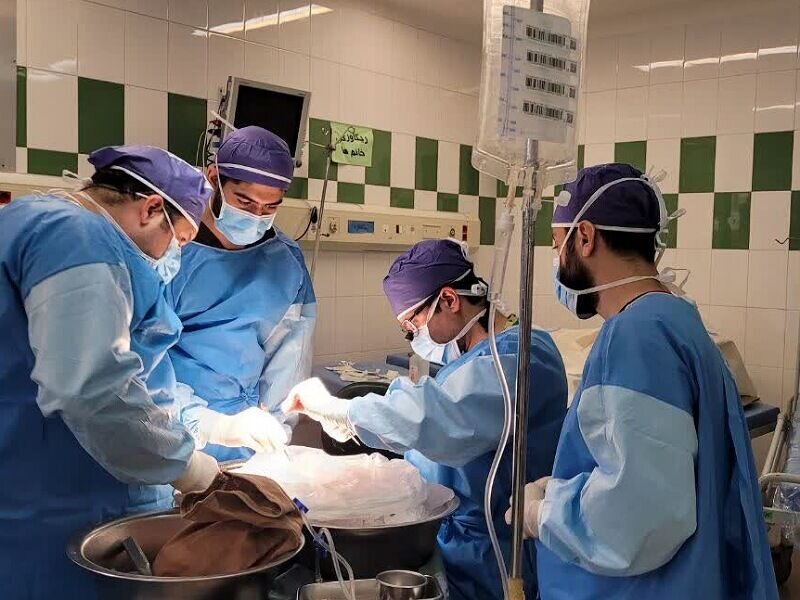Organ donation rises greatly in two years

TEHRAN - The number of organ donors in Iran has increased from 7.8 per million population (PMP) in the year 1399 (March 2020-March 2021) to 12.2 in the year 1401 (March 2022-March 2023).
“In 1399, the number of organ donations in the country was 645, which reached 928 in 1400 and increased to 1,016 in 1401,” Amir-Hesam Alirezaei, the head of the Health Ministry's Center for Transplantation and Disease Management, said.
Currently, 30 kidney transplant centers, 11 liver transplant centers, 3 lung transplant centers, 4 pancreas transplant centers, 18 bone marrow transplant centers, 22 procurement centers, and 35 transplant identification centers are active in the country, he explained.
With 40,095 cases, kidney transplant has had the highest number of transplants in the country, he noted.
Between 5,000 and 8,000 brain deaths occur annually in the country, he said, adding that 2,500 to 4,000 cases of brain deaths are eligible for organ transplantation, and there are 18,000 patients in need of receiving organs in the country, and more than 1,410 cases of organ donation were done last year, he concluded.
According to the Iranian Society of Organ Donation, there are two types of death in the medical world; Heart death (common death), which accounts for 99 percent of deaths worldwide, and brain death, which accounts for one percent of deaths.
There are over 25,000 patients in need of transplants on the waiting lists for various organs, but unfortunately, 7 to 10 of them die every day due to the lack of a transplanted organ, accounting for over 3,000 a year.
Considering that 7,000 transplant recipients are buried annually due to family dissatisfaction and 3,000 needy patients die, on the other hand, it can be considered that only half of the buried organs could save the lives of all.
Organ donation is an altruistic decision that can be made by family members after brain death. Although many organizations and medical centers have implemented various interventions and training courses to increase satisfaction with organ donation, a lack of organs for donation still is a serious problem in the world.
Iran tops Asian countries in organ donation
Mehdi Shadnoush, former head of the Health Ministry's Center for Transplantation and Disease Management, announced in June 2020 that Iran is ranked first for organ donation among Asian countries.
“The country’s organ donation rate is 14.34 per one million people,” he noted.
In February 2019, Shadnoush said that the organ donation rate has increased by 60 times over the past 18 years. Although Iran ranks 26 in organ donation in the world.
According to the figures revealed by the International Registry in Organ Donation and Transplantation (IRODaT), Spain leads the world in organ donation.
Health Minister Bahram Einollahi has said many countries in the region are asking Iran for help with issues related to health.
Emphasizing that all diseases are currently treated in the country, the minister added: “With the help of scientists, we were able to educate efficient human resources,” ISNA reported.
“With the efforts that have been made during the 44 years after the victory of the Islamic Revolution, today we have the strongest health system in the region in such a way that the health indicators in the Islamic Republic are far ahead of other countries in the region.”
All the indicators of health and treatment have made significant progress after the Islamic Revolution, and now Iran is one of the leading countries in this field, Saeed Karimi, the deputy health minister has said.
Health is one of the areas that got a good jump after the Islamic Revolution, ISNA quoted Karimi as saying.
It should be noted that in the early years of the Revolution, even for a cataract, which is a routine ophthalmic operation, the patient was sent abroad, but now patients from abroad come to Iran for the most advanced surgeries, he highlighted.
“At the beginning of the Revolution, there were just 56,000 hospital beds, but now we have 156,000 hospital beds,” he noted.
Meanwhile, there were just seven thousand specialists, but now there are 70 thousand specialists and sub-specialists in the country, he added.
In June 2021, Ahmed al-Mandhari, the World Health Organization director for Eastern Mediterranean Region, said the Islamic Republic of Iran is a role model for primary health care.
For the past four decades, its PHC network has aimed to ensure that people have timely access to affordable, accessible, and acceptable essential health services, he explained.
In October 2021, World Health Organization (WHO) representative to Iran Jaffar Hussain, said that Iran's health system can be a model for other countries in the region, especially in the field of health and the use of valuable forces such as healthcare providers.
The national budget bill for the current Iranian calendar year 1402, which started on March 21, has increased the health sector’s budget by 29 percent compared to the current year’s budget.
MG
Leave a Comment